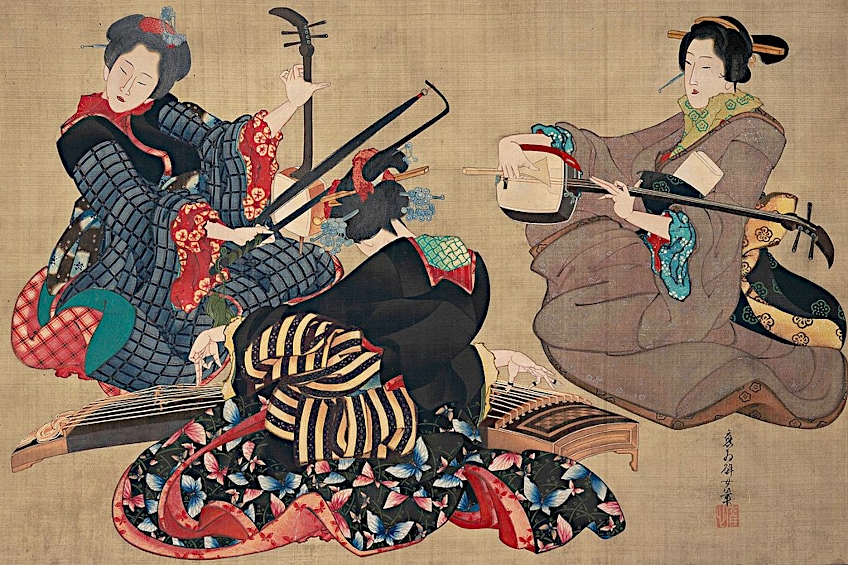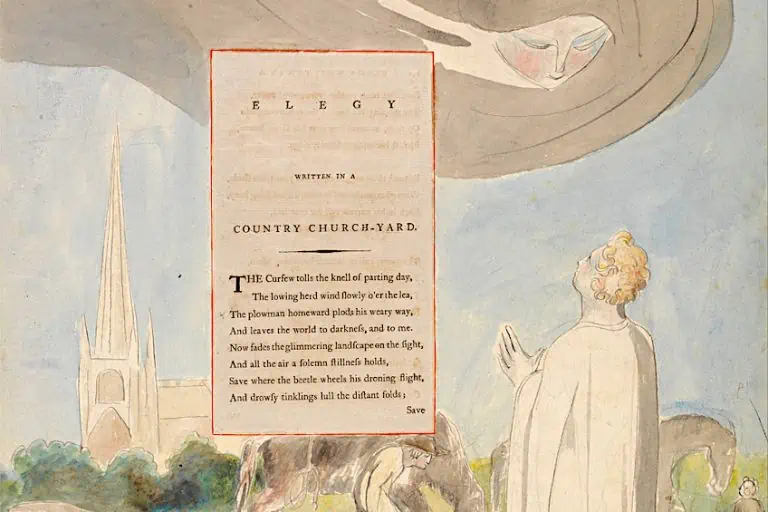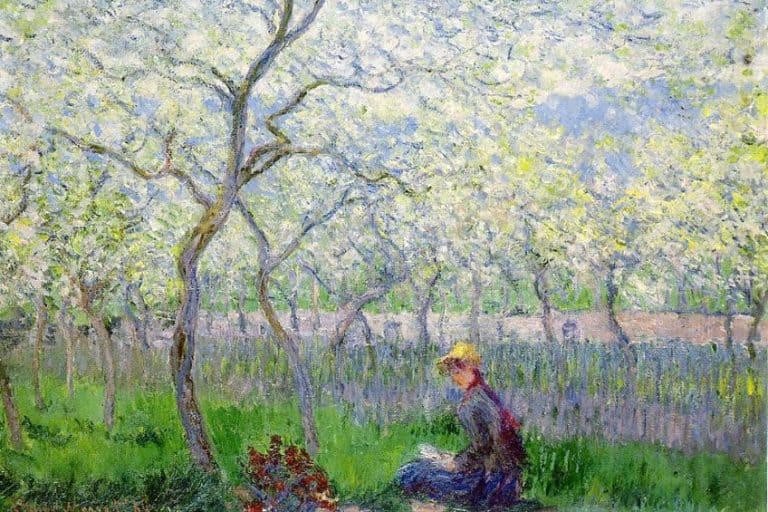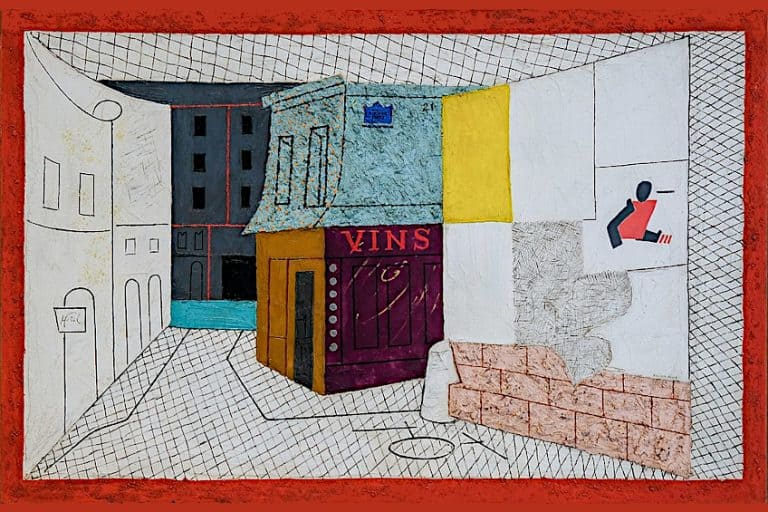Harmony in Art – How Artists Balance Visual Elements
This post may contain affiliate links. We may earn a small commission from purchases made through them, at no additional cost to you.
Harmony is an essential principle of art that helps create a sense of visual unity and coherence in any composition. It is achieved when different elements in an artwork work together to create a pleasing and balanced whole. The use of harmony in art is not limited to a specific medium or technique as it is found in all forms of art, from painting and sculpture to graphic design and photography. In this article, we will explore the different aspects of harmony in art, and provide examples of how artists have applied these principles in their works of art to create a sense of harmony and balance.
Table of Contents
- 1 Harmony in Art Definition: What Is Harmony in Art?
- 2 Examples of Harmony in Art
- 2.1 Harmony in Painting Through Line and Shape: Starry Night (1889) by Vincent van Gogh
- 2.2 Harmony in Painting Through Size: Les Demoiselles d’Avignon (1907) by Pablo Picasso
- 2.3 Harmony in Painting Through Texture: Composition VIII (1923) by Wassily Kandinsky
- 2.4 Harmony in Painting Through Idea: American Gothic (1930) by Grant Wood
- 2.5 Harmony in Painting Through Color: The Dance (1910) by Henri Matisse
- 3 Frequently Asked Questions
Harmony in Art Definition: What Is Harmony in Art?
Harmony in art refers to the pleasant combination of various components within an artwork. Pleasant here does not necessarily refer to beautiful, but rather to a feeling of “rightness”. It is the quality that brings a sense of integration and connectedness to artwork by creating a visual connection between different parts of the composition.
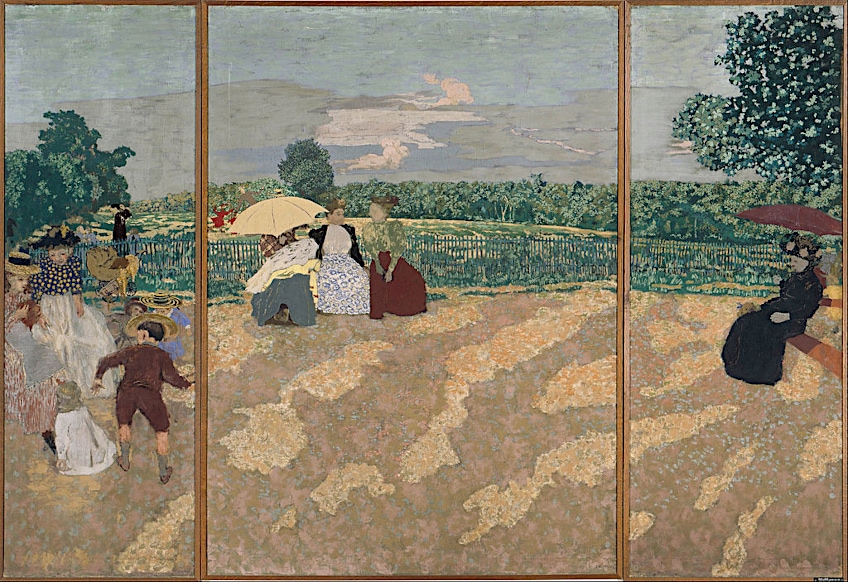 The Public Gardens by Édouard Vuillard (1894); Édouard Vuillard, Public domain, via Wikimedia Commons
The Public Gardens by Édouard Vuillard (1894); Édouard Vuillard, Public domain, via Wikimedia Commons
Harmony can be achieved through the use of various visual elements such as hue, shape, texture, and space. Harmony forms a part of what are called the principles of art. It specifically adds to the key principle of unity. Let us look at the principles of art to understand the technical concept of harmony in context and how it adds to the feeling of unity.
What Are the Principles of Art?
The codes of art are a set of guidelines used by artists to create visually appealing and well-composed artworks. These principles incorporate balance, distinction, emphasis, motion, pattern, tempo, and unity. Balance refers to the even allocation of elements in an artwork, creating a sense of tranquility and calmness. Whereas, Emphasis is the technique of highlighting a particular element to create a focal point or center of interest within the artwork.
 The Annunciation by Fra Angelico (between 1442 and 1443); Fra Angelico, Public domain, via Wikimedia Commons
The Annunciation by Fra Angelico (between 1442 and 1443); Fra Angelico, Public domain, via Wikimedia Commons
The principle of art that refers to creating a noticeable difference or contrast between elements within a work of art is called distinction. Distinction can be achieved through the use of various techniques such as contrasting colors, textures, or shapes, and is often used to create emphasis or draw attention to certain elements in a piece.
Motion is the principle of art that refers to creating a sense of movement or action within a work of art. Motion can be conveyed through a variety of techniques, such as the use of implied movement through directional lines, or the use of actual movement through kinetic sculptures. Tempo refers to the speed or pace of the visual elements within a work of art, and how they contribute to the overall mood or atmosphere of the piece. The tempo can be fast or slow, creating a sense of urgency or calmness, and can be influenced by the placement of elements within the composition, the use of color, and the repetition of shapes or patterns.
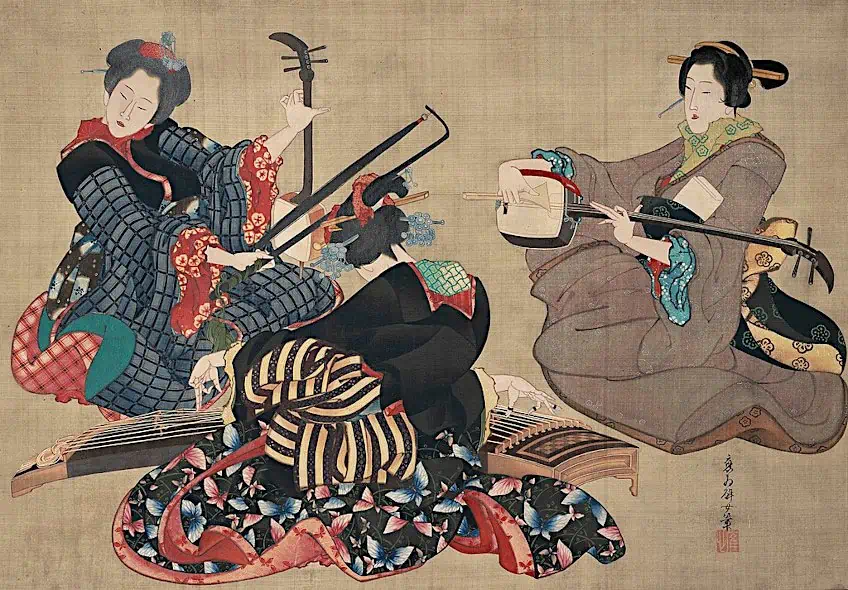 Three Women Playing Musical Instruments by Katsushika Ōi (between 1818 and 1844); Katsushika Ōi, Public domain, via Wikimedia Commons
Three Women Playing Musical Instruments by Katsushika Ōi (between 1818 and 1844); Katsushika Ōi, Public domain, via Wikimedia Commons
Pattern involves the repetition of elements, such as lines or shapes, to create a visual rhythm and sense of organization. Rhythm is the use of repeating patterns or movement to create a sense of flow and continuity within the artwork. Finally, unity is the technique of bringing together different elements of the artwork to create a sense of cohesiveness and harmony. By using these principles of art, creatives can create works that are both visually attractive and well-composed.
How Is Harmony Created by Artists?
In a 2D composition, harmony paintings, drawings, and prints display carefully balanced elements of the artwork. Artists can use a limited color palette, repeating shapes or patterns, or create a balance between positive and negative space to create a sense of harmony in the composition. For example, the use of similar colors, which are colors that are bordering each other on the color wheel, can create a feeling of consensus in a painting. Similarly, the use of repeating forms or patterns can create a sense of tempo and unity in a print.
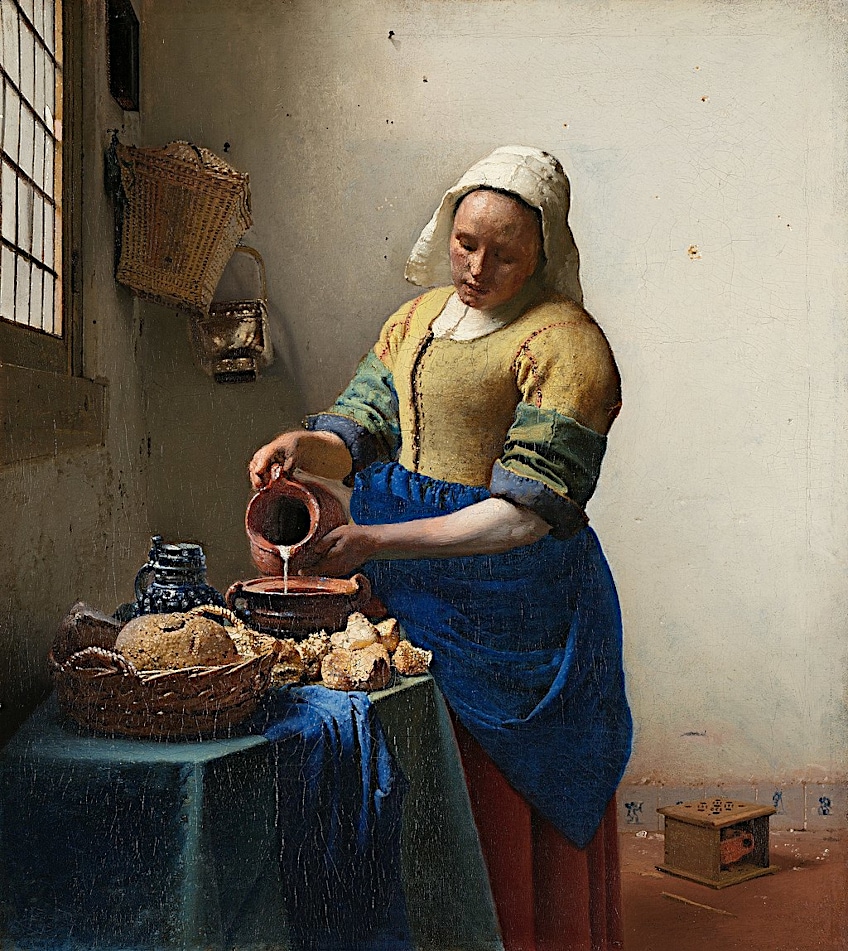 The Milkmaid by Johannes Vermeer (c. 1660); Johannes Vermeer, Public domain, via Wikimedia Commons
The Milkmaid by Johannes Vermeer (c. 1660); Johannes Vermeer, Public domain, via Wikimedia Commons
In 3D art such as sculptures and performance art, harmony can be achieved through the careful arrangement of different elements. Artists can use the principles of balance, proportion, and rhythm to create a sense of harmony within the artwork. For example, in sculpture, the use of symmetry or repeating shapes can create a sense of proportion and harmony. In performance art, the use of movement, sound, and lighting can create a harmonious and cohesive experience for the viewer.
 Detail of the saliera made for Francis I of France by Benvenuto Cellini (1543); Vassil, CC0, via Wikimedia Commons
Detail of the saliera made for Francis I of France by Benvenuto Cellini (1543); Vassil, CC0, via Wikimedia Commons
Examples of Harmony in Art
The principles of harmony in composition can be broken down into five aspects: line and shape, size, texture, idea, and color. In this section of the article, we will examine each aspect of harmony and provide an example artwork that illustrates how the type of harmony is applied and achieved.
Harmony in Painting Through Line and Shape: Starry Night (1889) by Vincent van Gogh
| Artist | Vincent van Gogh (1853 – 1890) |
| Date | 1889 |
| Medium | Oil on canvas |
| Dimensions (cm) | 74 x 92 |
| Style | Post-Impressionism and Expressionism |
| Location | The Museum of Modern Art, New York City, United States |
The first aspect of harmony is line and shape. In any composition, the use of lines and shapes can create a feeling of motion and stability. One example of this type of harmony can be seen in Vincent van Gogh’s (1853-1890) painting Starry Night (1889). The swirling lines and curves of the stars and the cypress tree create a sense of movement and flow, while the rectangular shapes of the houses and the town in the background provide a sense of stability.
 The Starry Night by Vincent van Gogh (1889); Vincent van Gogh, Public domain, via Wikimedia Commons
The Starry Night by Vincent van Gogh (1889); Vincent van Gogh, Public domain, via Wikimedia Commons
Harmony in Painting Through Size: Les Demoiselles d’Avignon (1907) by Pablo Picasso
| Artist | Pablo Picasso (1881 – 1973) |
| Date | 1907 |
| Medium | Oil on canvas |
| Dimensions (cm) | 243.9 × 233.7 |
| Style | Proto-Cubism |
| Location | The Museum of Modern Art, New York City, United States |
The second aspect of harmony is size. In any composition, the careful arrangement of different elements in terms of size can create a sense of proportion and balance. One example of this type of harmony can be seen in Pablo Picasso’s (1881 – 1973) painting Les Demoiselles d’Avignon (1907). The large and powerful figures in the foreground are balanced by the smaller figures in the background, creating a sense of harmony and balance within the composition.
Harmony in Painting Through Texture: Composition VIII (1923) by Wassily Kandinsky
| Artist | Wassily Kandinsky (1866 – 1944) |
| Date | 1923 |
| Medium | Oil on canvas |
| Dimensions (cm) | 140 x 201 |
| Style | Abstract Art |
| Location | Solomon R. Guggenheim Museum, New York City, United States |
The third aspect of harmony is texture. The usage of texture can create a feeling of depth and complexity within a composition. One example of this type of harmony can be seen in Wassily Kandinsky’s (1866 – 1944) painting Composition VIII (1923). The use of different textures, such as the smooth, flat areas of color contrasted with the rough, textured areas, creates a sense of depth and visual interest within the composition.
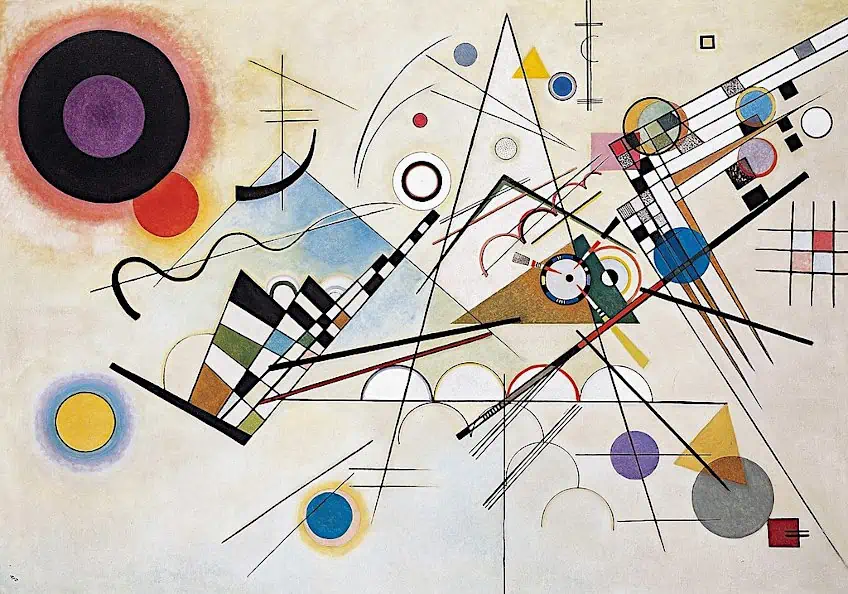 Composition VIII by Wassily Kandinsky (1923); Wassily Kandinsky, Public domain, via Wikimedia Commons
Composition VIII by Wassily Kandinsky (1923); Wassily Kandinsky, Public domain, via Wikimedia Commons
Harmony in Painting Through Idea: American Gothic (1930) by Grant Wood
| Artist | Grant Wood (1891 – 1942) |
| Date | 1930 |
| Medium | Oil on canvas |
| Dimensions (cm) | 74 x 62 |
| Style | Modernism |
| Location | School of the Art Institute of Chicago, Chicago, United States |
The fourth aspect of harmony is idea. This involves the use of concepts, themes, or motifs that tie different elements of the composition together. One example of this type of harmony can be seen in Grant Wood’s (1891 – 1942) painting American Gothic (1930). The use of the pitchfork motif throughout the painting ties together the different elements, creating a sense of unity and cohesiveness.
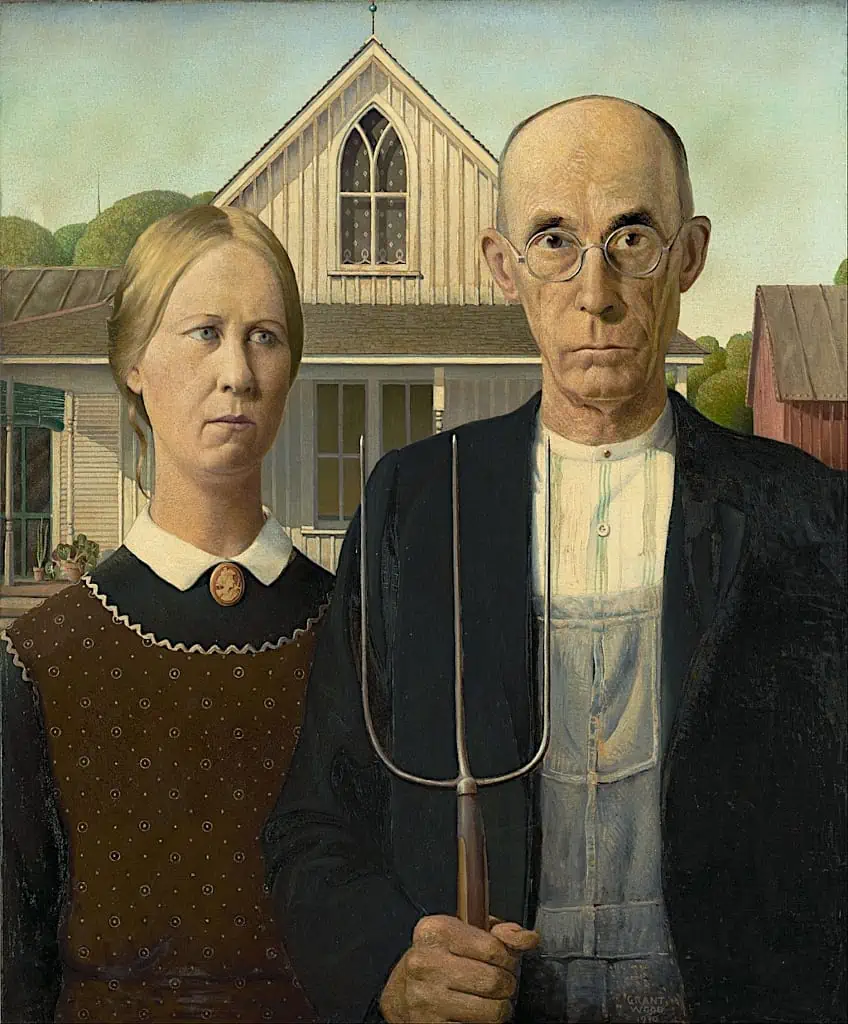 American Gothic by Grant Wood (1930); Grant Wood, Public domain, via Wikimedia Commons
American Gothic by Grant Wood (1930); Grant Wood, Public domain, via Wikimedia Commons
Harmony in Painting Through Color: The Dance (1910) by Henri Matisse
| Artist | Henri Matisse (1869 – 1954) |
| Date | 1910 |
| Medium | Oil on canvas |
| Dimensions (cm) | 260 x 391 |
| Style | Fauvism |
| Location | The Museum of Modern Art, New York City, United States |
The fifth and final aspect of harmony is color. The careful use of color can create a sense of mood, atmosphere, and unity within a composition. One example of this type of harmony can be seen in Henri Matisse’s (1869 – 1954) painting The Dance (1910). The use of bold, vibrant colors creates a sense of joy and energy within the composition, while the repetition of these colors throughout the painting creates a sense of unity and cohesiveness.
In conclusion, harmony in art is a key principle that involves creating a sense of balance and unity within an artwork. It is achieved through the careful use of color, form, texture, and space, and can be seen in a variety of mediums, from painting and drawing to sculpture and performance art. Some examples of harmony in art include the use of complementary colors in a painting, the repetition of shapes and patterns in a sculpture, or the synchronized movements of dancers in a performance piece. Understanding the principles of art, such as balance, contrast, and movement is essential to creating harmonious and visually engaging artwork. Ultimately, the skillful use of harmony in art can enhance the emotional impact and overall aesthetic quality of an artwork.
Frequently Asked Questions
What Is Harmony in Art?
The harmony in art definition points to the pleasing mixture of different features in an artwork, creating a sense of unity and cohesiveness. It is achieved through the careful balancing of color, form, texture, and space, and can be seen in both 2D and 3D compositions. Overall, harmony helps to create visually pleasing and balanced artworks.
Why Is Harmony in Art Important?
Overall, harmony is a crucial technical quality in art that helps to bring different elements together and create cohesive and visually pleasing artwork. By skillfully balancing different elements, artists can create works that not only look aesthetically pleasing, but also convey a sense of order and balance to the viewer.
How Is Harmony in Art Achieved?
The principles of harmony in art can be achieved through the careful balancing of line and shape, size, texture, idea, and color. Understanding and applying these principles can bring a sense of balance and cohesiveness to any composition, enhancing the emotional impact and overall aesthetic quality of the artwork.
In 2005, Charlene completed her wellness degrees in therapeutic aromatherapy and reflexology at the International School of Reflexology and Meridian Therapy. She worked for a company offering corporate wellness programs for several years before opening her own therapy practice. In 2015, she was asked by a digital marketer friend to join her company as a content creator, and it was here that she discovered her enthusiasm for writing. Since entering the world of content creation, she has gained a lot of experience over the years writing about various topics such as beauty, health, wellness, travel, crafting, and much more. Due to various circumstances, she had to give up her therapy practice and now works as a freelance writer. Since she is a very creative person and as a balance to writing likes to be active in various areas of art and crafts, the activity at acrylgiessen.com is perfect for her to contribute their knowledge and experience in various creative topics.
Learn more about Charlene Lewis and about us.
